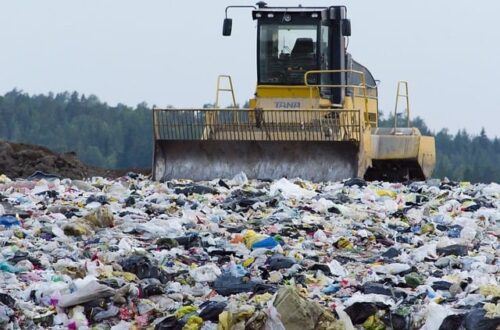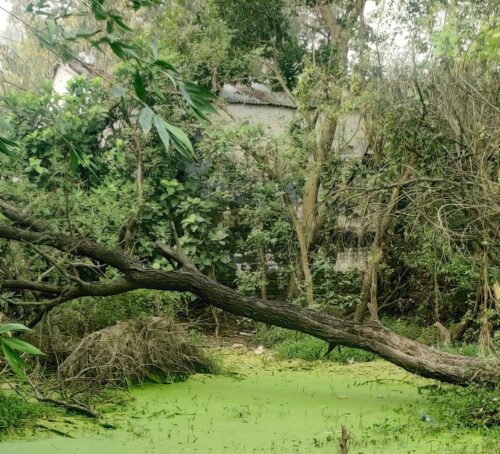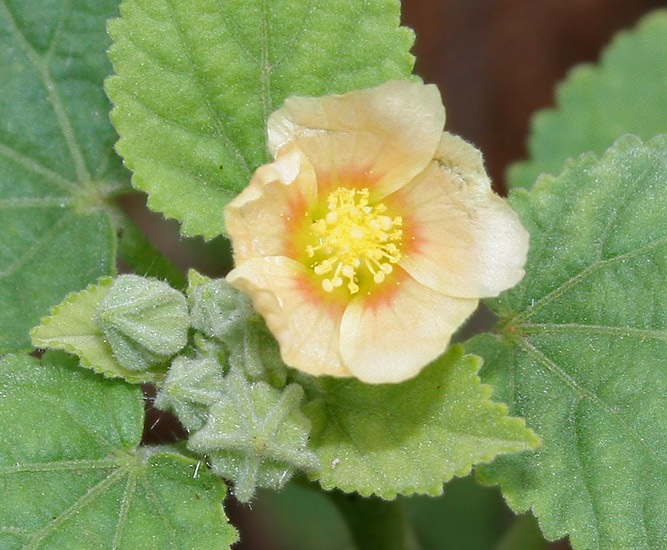Landfilling is the process of disposing solid waste in low lands or into trenches through proper sanitary methods. It involves- collection, transport, compaction, etc. processes along with proper management for gas-outlet etc. For land filling, the important thing to be taken into account is the distance of waste collection site to the waste dumping site, because it involves cost of transportation.
The process of land filling is similar to dumping in very general sense. However, it is different from dumping as it involves scientific method of disposal of wastes into low land sides, without creating hazards to the community health or safety.
The overall process of land filling involves following methods- Area Method, Trench Method, and Ramp Method. In Area Method, solid wastes are pulverised and spread over the entire area. Then, the waste is compacted by the rolling of bull dozers. A layer of soil is spread over the layer of compressed waste and the entire area is again pressed by rolling bull dozers. The same process is repeated a number of times.
In the Trench Method, trenches measuring 10x5x20 feet3 are dug and heaps of solid wastes are filled into them. These trenches are compacted by rolling of bull dozers. The top and sides of trenches are covered with soils. This method needs at least one acre of land to handle the solid waste generated by about 10, 000 people in a time period of one year.
In Ramp Method, a number of gullies, ravines or quarries are dug for land filling. Natural gullies made by soil erosion may also be selected for filling. Solid wastes are filled along the slopes, then covered with soil and pressed properly.
The selection of site for land filling is done on the basis of following considerations-
(i) Availability of land and area.
(ii) Accessibility to the land site.
(iii) Availability of soil for the use as cover material.
(iv) Climate of the area in which the land fill site is located.
(v) The topography of the area selected for land filling.
The process of land filling has following advantages-
(i). Flies, rats and other pests cannot breed in landfills.
(ii). Chances of fire hazards are reduced through this method.
Land filling has following disadvantages-
(i). It may cause ground water pollution by leaching down of liquefied wastes during rains.
(ii). A landfill may cause water pollution if located near a water source.
(iii). The land fill site becomes unfit for the human settlement due to release of gases like methane, carbon dioxide and sometimes radon, within the period of first few years. These gases are produced due to the decomposition of filled-in wastes.
(IV)Incineration: The process of burning of solid waste under scientifically controlled and safe conditions is called as incineration. In this process, waste is burnt in moving grates in refractory lined chambers. The combustible gases and solids they carry are burned in Secondary Chambers.
Since the human beings learnt to control fire, they started incinerating wastes. In those day’s incineration meant just to burn the waste. But in modern times it is rather a complicated process which incorporates burning of waste with control on hazardous emission and utilization of heat energy for useful purposes. In today’s practice, incineration is a preferred method of handling infectious medical waste.
The emission from incineration is usually controlled by Wet Scrubbers, Electrostatic Precipitators, or by Fabric Filters. The heat so generated, can be used for producing steam to convert it into mechanical or electrical energy.

Wet scrubbers are specific devices that are usually fitted in chemical and metallurgical industries to trap emissions like sulphur dioxide, ammonia and metal fumes. For containing and collecting wastes like different solvents, toxic vapours and dust particles, wet scrubbers are further fitted with traps and condensers.
Electrostatic precipitators are electric operated devices that are usually fitted in power plants and other industries to control air pollution due to these plants and industries. These are highly efficient devices with absolute efficiency. In these machines, electrodes are fitted to attract charged particulates present in the air or the gaseous emissions.
Fabric filters, as the name indicates, comprise many bags of fabric to collect particulates. These bags collect particulate matter like vacuum cleaners.
The process of incineration is not applied for the handling and disposal of the toxic heavy metal or the chlorinated hydrocarbons also. The chlorinated hydrocarbons produce hydrochloric acid and dioxins on burning.
Dioxins, according to the Encyclopaedia Britannica – ‘any of a group of chemical compounds that is an undesirable by-product in the manufacture of herbicides, disinfectants, and other agents’ is called as dioxins. In popular terminology, dioxin has become a synonym for one specific dioxin, 2, 3, 7, 8-tetrachlorodibenzo-p-dioxin (2, 3, 7, 8-TCDD).
On the other hand, when old painted surfaces are burnt, they produce lead or arsenic into air. The burnt residue left after incineration is also considered as hazardous. That’s why it should also be handled carefully. About 6 per cent of the hazardous wastes in the United States is incinerated, and the remaining 11 per cent is burnt along with fuel.





We have Developed a Easy to Handle, Non recyclable waste, sizes below 6″, normally unsaggrigated, No value, thrown, Roadside Litter, a System which is a Controlled Incineration with No Smoke or Smokeless,on the Go (Portable) unit.